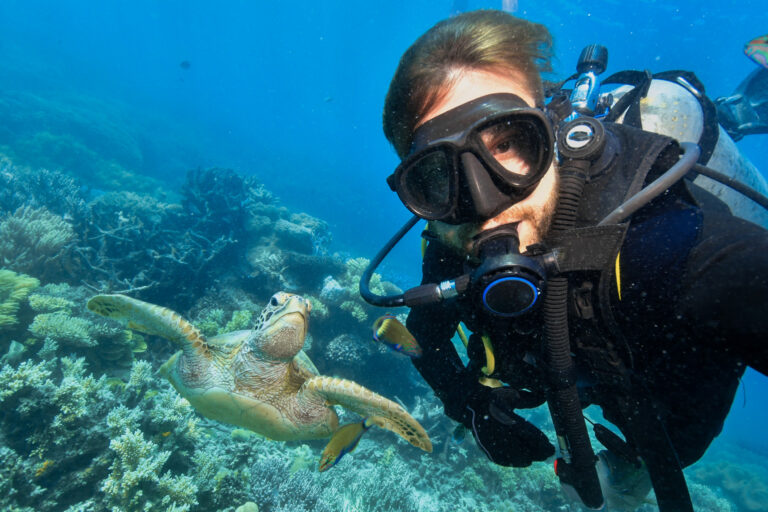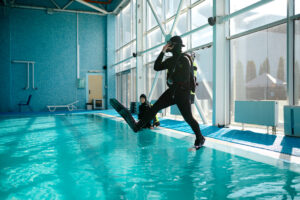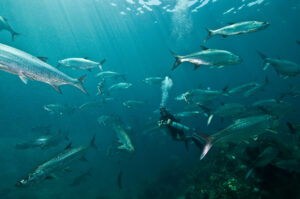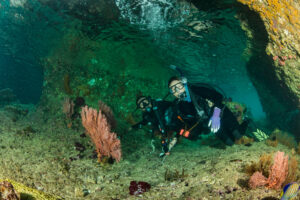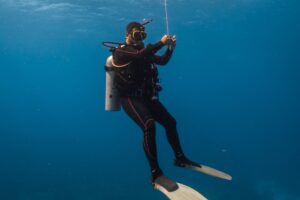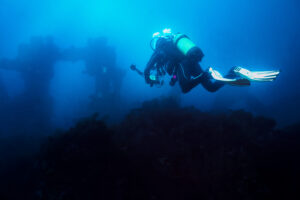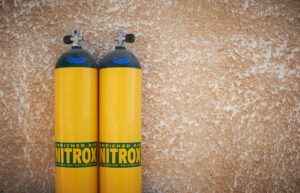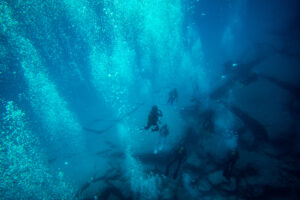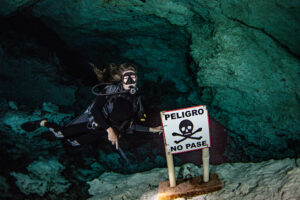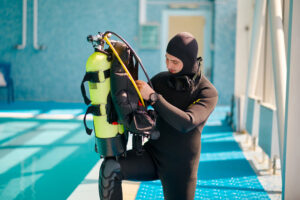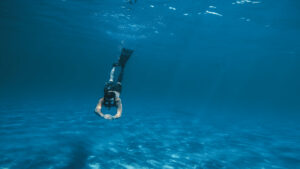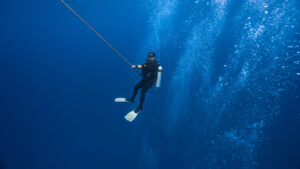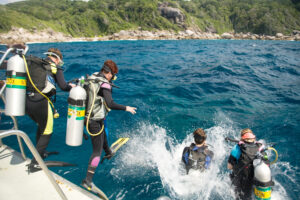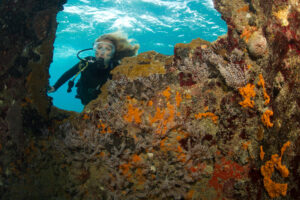What is a Dry Snorkel?
A dry snorkel is a specialized piece of snorkeling equipment designed to keep the snorkeler’s airway dry by preventing water from entering the tube. Unlike traditional snorkels, which can allow water to enter when submerged or faced with waves, dry snorkels feature a unique valve mechanism at the top. This mechanism seals off the snorkel tube when submerged, ensuring that the user can breathe comfortably and without interruption once back at the surface. The advent of the dry snorkel has significantly improved the snorkeling experience, offering greater comfort and safety, particularly for beginners and those snorkeling in rougher waters.
Historical Development of the Dry Snorkel
The concept of snorkeling dates back thousands of years, with early evidence suggesting that ancient cultures used hollow reeds to breathe while submerged. Over time, the design and functionality of snorkeling equipment have evolved significantly. In the mid-20th century, modern snorkels became more standardized, typically consisting of a simple J-shaped tube and mouthpiece. These traditional snorkels, however, had a common issue: water entering the tube, leading to discomfort and the need for frequent clearing.
The development of the dry snorkel began as an innovative solution to this problem. Early attempts at creating a water-blocking snorkel involved adding splash guards and purge valves, but these did not fully address the issue of water entering the tube when submerged. The breakthrough came with the introduction of the float valve mechanism, which automatically seals the top of the snorkel when it is submerged. This design was first popularized in the late 1990s and early 2000s and has since undergone numerous refinements to improve reliability and user comfort.
Significant milestones in the evolution of dry snorkels include the integration of ergonomic mouthpieces and the use of advanced materials to enhance durability and flexibility. These advancements have made dry snorkels more effective and user-friendly, contributing to their widespread adoption among snorkelers of all skill levels.
Design and Technology
The design of a dry snorkel is characterized by several key components that work together to keep the snorkel dry. The most critical feature is the float valve mechanism located at the top of the snorkel. This mechanism typically consists of a buoyant float that rises when submerged, sealing off the snorkel tube with a watertight barrier. Once the snorkel is back above water, the float drops, reopening the tube for breathing.
Another essential component of the dry snorkel is the splash guard. This is a secondary defense that helps prevent water from entering the snorkel in choppy conditions or when the snorkeler’s head is hit by waves. The combination of the float valve and splash guard makes dry snorkels particularly effective in maintaining a dry airway, even in challenging environments.
Dry snorkels are usually made from materials such as silicone and durable plastics. Silicone is commonly used for the mouthpiece and flexible sections of the snorkel, offering comfort and a good seal around the mouth. The rigid parts of the snorkel, including the tube and valve housing, are typically made from high-quality plastics designed to withstand the rigors of marine environments.
Comparatively, traditional snorkels lack the advanced valve systems of dry snorkels and often require manual clearing to expel water. Semi-dry snorkels, which include splash guards and purge valves but not the complete sealing mechanism of dry snorkels, offer a middle ground. However, the fully automatic operation of dry snorkels provides a significant advantage in terms of ease of use and safety.
Materials and Manufacturing
Dry snorkels are constructed using a variety of materials chosen for their specific properties. Silicone is a preferred material for the mouthpiece due to its softness and flexibility, which ensures a comfortable fit and minimizes jaw fatigue during extended use. Additionally, silicone is resistant to the saltwater environment, preventing degradation over time.
The main tube and other rigid parts of the snorkel are typically made from high-impact plastics. These plastics are chosen for their durability and ability to retain their shape under pressure. The use of such materials ensures that the snorkel can withstand accidental drops and the general wear and tear associated with snorkeling activities.
Manufacturing a dry snorkel involves several steps, beginning with the molding of individual components. Injection molding is a common technique used to create the plastic parts, allowing for precise shaping and the integration of complex features such as the float valve mechanism. The silicone mouthpieces are also molded to achieve the desired shape and comfort level.
Once the components are molded, they are assembled, often by hand, to ensure that the float valve mechanism and other moving parts function correctly. Quality control is a crucial aspect of the manufacturing process, with each snorkel undergoing testing to verify the proper operation of the valve and the overall integrity of the assembly. Innovations in materials and manufacturing techniques continue to enhance the performance and durability of dry snorkels, making them more accessible and reliable for snorkelers worldwide.
Usage and Applications
Using a dry snorkel is straightforward, but understanding the correct technique can enhance the snorkeling experience. To use a dry snorkel, one must first ensure that the snorkel is securely attached to the mask strap. The mouthpiece should be placed comfortably in the mouth, with lips forming a seal around it. The snorkel tube should extend upwards, allowing the float valve to function correctly.
Dry snorkels are particularly beneficial in certain conditions and scenarios. For instance, they are ideal for snorkeling in choppy waters where waves can frequently splash over the snorkel. The float valve prevents water from entering, allowing the snorkeler to focus on observing marine life rather than clearing water from the snorkel. Additionally, dry snorkels are advantageous for beginners who might struggle with traditional snorkels’ need for frequent clearing.
For underwater photographers, a dry snorkel can be a valuable tool. It allows them to concentrate on capturing the perfect shot without worrying about inhaling water. The ability to breathe comfortably without interruption is essential for maintaining composure and achieving steady, clear images.
Maintaining a dry snorkel involves regular cleaning and inspection. After each use, it is important to rinse the snorkel with fresh water to remove salt and debris. Allowing it to air dry thoroughly prevents mold and mildew growth. Periodic checks for wear and tear, particularly on the float valve mechanism and mouthpiece, help ensure the snorkel remains in good working condition.
Advantages and Limitations
One of the primary advantages of a dry snorkel is the comfort it provides by keeping the snorkeler’s airway dry. This feature is particularly appreciated by beginners, who might find the experience of inhaling water through a traditional snorkel intimidating or uncomfortable. The automatic sealing mechanism of the dry snorkel eliminates the need for manual clearing, making snorkeling more enjoyable and less stressful.
Another benefit is the safety aspect. The ability to keep water out of the snorkel reduces the risk of choking and ensures that the user can breathe freely even in rough conditions. This is especially important for snorkelers who venture into more challenging environments where waves and splashes are common.
However, dry snorkels also have some limitations. The complexity of the float valve mechanism means there is a potential for malfunction. If the valve fails to seal properly, water can enter the snorkel, negating its primary advantage. Regular maintenance and quality checks are essential to ensure the snorkel functions as intended.
Additionally, dry snorkels can be bulkier and more expensive than traditional or semi-dry snorkels. The added components and advanced design contribute to a higher price point, which might be a consideration for budget-conscious snorkelers. The bulkier design can also make them less comfortable for some users, particularly those with smaller faces or who prefer a more streamlined snorkel.
Impact on Snorkeling Community
The introduction of dry snorkels has had a significant impact on the snorkeling community, particularly among recreational snorkelers and beginners. By addressing common issues associated with traditional snorkels, such as water ingress and the need for frequent clearing, dry snorkels have made snorkeling more accessible and enjoyable for a wider audience.
Experienced snorkelers and professionals have also benefited from the advancements in dry snorkel technology. The ability to maintain a dry airway in challenging conditions enhances safety and comfort, allowing for longer and more immersive snorkeling sessions. The adoption of dry snorkels has been particularly notable in regions with rougher waters, where the additional protection provided by the float valve mechanism is invaluable.
Market presence and adoption rates of dry snorkels vary by region, with higher uptake in areas known for snorkeling tourism. Feedback from the snorkeling community has generally been positive, with many users praising the convenience and comfort of dry snorkels. Some users, however, continue to prefer traditional or semi-dry snorkels due to their simplicity and lower cost.
The future of dry snorkels looks promising, with ongoing innovations aimed at improving their reliability and user experience. As manufacturers continue to refine the design and materials, dry snorkels are likely to become even more popular, further enhancing the snorkeling experience for enthusiasts worldwide.
Key Takeaways
Dry snorkels represent a significant advancement in snorkeling equipment, offering enhanced comfort and safety by preventing water from entering the snorkel tube. The development and refinement of dry snorkel technology have made snorkeling more accessible and enjoyable, particularly for beginners and those snorkeling in challenging conditions. Despite some limitations, the benefits of dry snorkels are widely recognized, and their impact on the snorkeling community has been substantial. As technology continues to evolve, dry snorkels are poised to become an even more integral part of the snorkeling experience.

